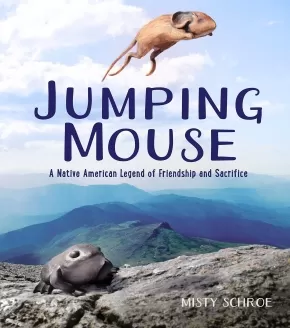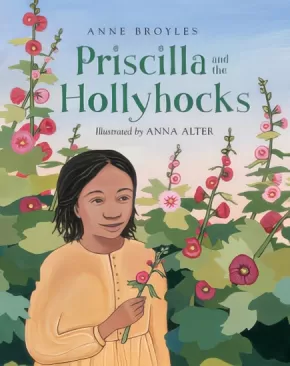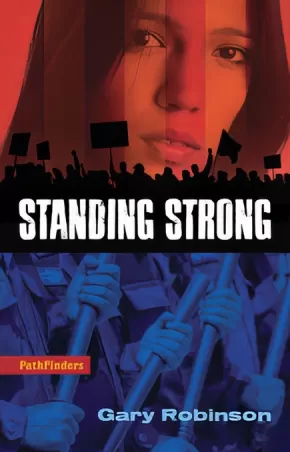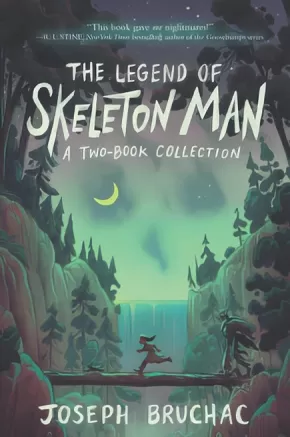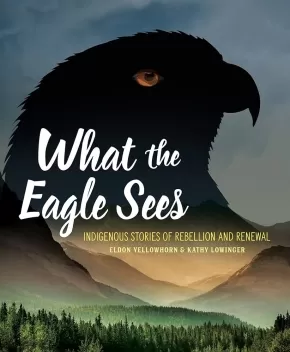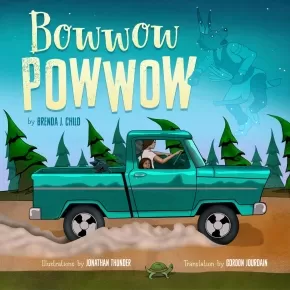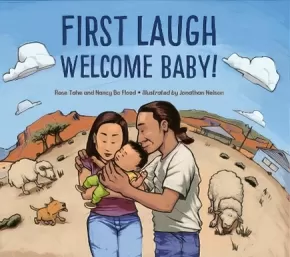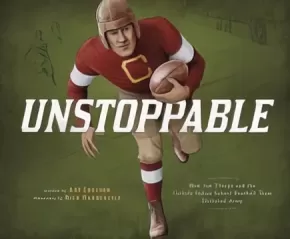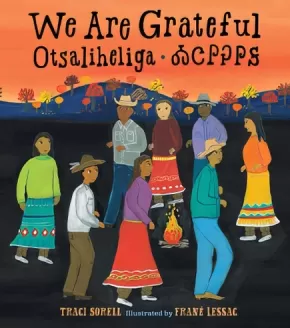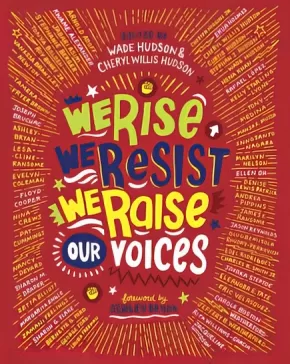
Indigenous Peoples in the United States
256
-
270
of
343 Results;
Sort By
Go To
of 23
Jumping Mouse: A Native American Legend of Friendship and Sacrifice
$26.95
Artists:
Format:
Hardcover
Text Content Territories:
Indigenous American; Native American;
ISBN / Barcode: 9781624148170
Synopsis:
Synopsis:
Jumping Mouse is just like another other mouse, except she has a dream—a dream to reach the fabled High Places. But one small mouse can’t make the long journey alone. At the start of her journey, Jumping Mouse is gifted new long legs from wise Grandfather Frog. Filled with gratitude, she soon meets others who need assistance just like she did: a buffalo that cannot see and a wolf that cannot smell. In order to aid them, she must sacrifice her own sight and hearing, putting her dream of the High Places at risk. Through perseverance and belief, Jumping Mouse discovers who she was truly meant to be, and demonstrates the value of friendship, selflessness, and sacrifice.
Characters come to life through striking photographs of ash-fired ceramic sculptures, giving a fresh twist to this retelling of a timeless tale from the oral tradition.
Educator Information
Recommended for ages 4 to 8.
Additional Information
32 pages | 10.62" x 9.45"
Nowhere to Hide
$12.95
Format:
Paperback
Text Content Territories:
Indigenous American; Native American; Anishinaabeg; Ojibwe (Chippewa); Minnesota Chippewa Tribe; White Earth Band of Ojibwe;
ISBN / Barcode: 9781939053213
Synopsis:
Synopsis:
Autumn Dawn is sick of being bullied at school. It's not her fault that she doesn't learn as fast as the other kids or that she speaks a little differently. Her home life isn't much better. Ever since Autumn's dad left, her mother can't cope, so Autumn has to care for her baby brother and do all the housework. Her mother hasn't even noticed the problems her daughter is dealing with.
When Autumn's Ojibwa aunt comes to visit, she recognizes Autumn's dyslexia and speech problems. Can Aunt Jessie build a bridge between mother and daughter and give Autumn the confidence she needs to move past her challenges?
Educator & Series Information
Recommended Ages: 12 to 16
Fry Reading Level: 4
This book is part of the PathFinders series. The PathFinders series of Hi-Lo (high interest, low readability) novels offers the following features:
• Indigenous teen protagonists
• Age-appropriate plots
• 2.5 – 4.5 Reading Level
• Contemporary and historical fiction
• Indigenous authors
The PathFinders series is from an American publisher. Therefore, Indigenous terminology in the PathFinders books is not the same as Canadian Indigenous terminology. This prompts a useful teaching moment for educators in discussing appropriate terminology use in Canada.
This book is part of the Autumn Dawn Series, a subseries of the PathFinders series.
Additional Information
120 pages | 4.50" x 7.00"
Priscilla and the Hollyhocks
$9.99
Artists:
Format:
Paperback
Text Content Territories:
Indigenous American; Native American; Cherokee;
ISBN / Barcode: 9781570916762
Synopsis:
Synopsis:
Priscilla is only four years old when her mother is sold to another master. All Priscilla has to remember her mother by are the hollyhocks she planted by the cow pond. At age ten, Priscilla is sold to a Cherokee family and continues her life as a slave. She keeps hope for a better life alive by planting hollyhocks wherever she goes. At last, her forced march along the Trail of Tears brings a chance encounter that leads to her freedom.
Includes an author's note with more details about this fascinating true story as well as instructions for making hollyhock dolls.
Reviews
"While researching the Cherokee Trail of Tears for a novel she was writing, Anne Broyles discovered Priscilla’s story. Priscilla and the Hollyhocks offers a somewhat different story of slavery in America, a story unknown to many — or at least to me, anyway — African slaves who were not owned by whites, but by Native Americans." - Don Tate for The Brown Bookshelf
"When Priscilla's mother is sold to a new owner and the two are separated, the young slave girl finds solace in her mother's hollyhock patch. As she grows older, the kind words of a white businessman, Basil Silkwood, instill in Priscilla a desire to attend school, but she is soon sold to a Cherokee family, and her life of servitude continues. As her Native American owners embark on the grueling journey west, known as the 1838 "Trail of Tears," she again meets the compassionate Silkwood, who purchases her freedom.... Based on real events, Broyles' poetic and colloquial narrative, voiced by a grown Priscilla, ends with the girl sowing the seeds of her mother's hollyhocks near her new home with the Silkwoods and an author's note detailing the historical basis of the story." - Kristen McKulski, Booklist
"This is a well written story based on facts. Anne Broyles takes us on a journey into Priscilla’s childhood as she is sold from one family to another until she found Massa Silkwood who set her free and adopted her into his family of fifteen. Priscilla was not only saved by Mr. Silkwood but also by hollyhocks. Old Sylvia told her how her mother will make hollyhock dolls and set it to sail on the cow pond. When she watches her flower dolls float on the cow pond she felt her mother’s smile. Is show how the flowers represented a strong memory of her mother who was sold when she was a very young child. Priscilla always had a hand full of seeds with her and planed them where ever she went. She was sold to a Cherokee family when her master died. Read about the brief history of the Cherokee as they were told to leave their homes and lands. Priscilla found freedom and a happy life thereafter. Great illustrations by Anna Alter which capture the story. I highly recommend this book for every schools and libraries." - Mymcbooks
Educator Information
Recommended for ages 6 to 9.
Additional Information
32 pages | 8.56" x 11.06"
Standing Strong
$12.95
Format:
Paperback
Text Content Territories:
Indigenous American; Native American;
ISBN / Barcode: 9781939053220
Synopsis:
Synopsis:
Like some other Native teens on Montana reservations, Rhonda Runningcrane attempted suicide. To her, life seemed bleak and pointless. But when she learns that donations are needed to support a large protest against an oil company running a pipeline through sacred Native land, something inside her clicks. Unlike her friends, Rhonda is inspired to join the fight, even though she knows it could be dangerous.
Using skills she learned from her uncle, Rhonda becomes part of the crew that keeps the protesters' camp running. With inspiration from a wise Native elder, the teen commits herself to an important cause, dedicating her life to protecting the sacred waters of Mother Earth.
Educator & Series Information
Recommended for ages 12 to 16.
Fry Reading Level: 6
This book is part of the PathFinders series. The PathFinders series of Hi-Lo (high interest, low readability) novels offers the following features:
• Indigenous teen protagonists
• Age-appropriate plots
• 2.5 – 4.5 Reading Level (With exception of this title, which has a Fry Reading Level of 6)
• Contemporary and historical fiction
• Indigenous authors
The PathFinders series is from an American publisher. Therefore, Indigenous terminology in the PathFinders books is not the same as Canadian Indigenous terminology. This prompts a useful teaching moment for educators in discussing appropriate terminology use in Canada.
Additional Information
120 pages | 4.50" x 7.00"
The Legend of Skeleton Man: Skeleton Man and The Return of Skeleton Man
$9.99
Format:
Paperback
Text Content Territories:
Indigenous American; Native American; Haudenosaunee (Iroquois); Kanyen'keha:ka (Mohawk); Akwesasne (Ahkwesáhsne);
ISBN / Barcode: 9780062747686
Synopsis:
Synopsis:
This spine-tingling middle-grade collection brings together Skeleton Man and The Return of Skeleton Man—two modern classics that will chill you to the bone.
Molly’s father grew up on the Mohawk Reserve of Akwesasne, where he learned the best scary stories. One of her favorites was the legend of Skeleton Man, a gruesome tale about a man with a deadly, insatiable hunger. But ever since her parents mysteriously vanished, those spooky tales have started to feel all too real.
And things go from bad to worse for Molly when a stranger shows up one day and claims to be her great-uncle. A ghostly thin man she’s never seen before. A man who reminds her an awful lot of the Skeleton Man. But he couldn’t possibly be the same person from her father’s tale . . . could he? It’s up to Molly to uncover the truth about this fearsome figure and rescue her parents before it’s too late.
This 2-in-1 collection is perfect for fans of R.L. Stine, Ellen Oh’s Spirit Hunters series, Holly Black’s Doll Bones, and any young reader who loves a good thrill.
Educator Information
Recommended for ages 8 - 12.
Additional Information
288 pages | 5.12" x 7.62"
The Powwow Thief
$13.45
Artists:
Format:
Paperback
Text Content Territories:
Indigenous American;
ISBN / Barcode: 9781478868965
Synopsis:
Synopsis:
Twins Jamie and Marie Longbow are excited about summer with their grandparents, traveling from powwow to powwow selling goods they helped make. When their grandmother's most beautiful necklace goes missing, it's up to the twins to solve the mystery.
Reviews
"Marie Longbow and her twin brother Jamie accompany their grandparents to a powwow to sell jewelry and regalia. After the family returns from participating in the Friendship dance, they find that Grama’s best piece of jewelry is missing. Using both brains and brawn, the twins track down a surprising thief. The cartoonish drawings have a pop art feel with bright colors, and comic panels are incorporated into the single- and double-page illustrations. A variety of regalia is depicted on the dancers and drummers. Speech bubbles are used for some of the text to emphasis parts of the conversations. Native American terms are sprinkled into the narrative along with descriptions of powwow activities. The book is divided into short chapters, creating a sort of picture book/graphic novel hybrid, which should appeal to emerging and/or reluctant readers. VERDICT This beginning mystery with a Native American focus is a good general purchase, and creates a useful transition from picture books to chapter books or graphic novels for younger readers." —School Library Journal Reviewer
"This early chapter book with a picture book trim size, the first installment of the Powwow Mystery Series, features twins Jamie and Marie Longbow, who are traveling to powwows this summer with their grandparents to sell Grama’s wares. Jamie excels at tree climbing, while Marie loves to read and memorize facts about birds. When Grama’s best necklace is stolen at the Little Eagle powwow grounds, the first powwow they visit, it’s up to the twins and their respective talents to help solve the case. Bruchac (Brothers of the Buffalo), an enrolled member of the Nulhegan Bank of the Abenaki nation, offers a well-paced introduction of the characters and elements of the powwow over the four chapters. While the foreshadowing may be a bit transparent (“ ‘It’s okay,’ Grampa said as he danced past them. ‘Sleepy Mickey is watching the booth.’ ”), the identity of the thief and the resolution still prove satisfying. Deforest, who was raised on the Navajo reservation in New Mexico, contributes boldly outlined and brightly colored digital illustrations in an accessible comic-book style that will likely entice reluctant readers."—Publishers Weekly
Educator & Series Information
Recommended for grades 2 to 5.
This book is part of the Powwow Mystery series.
Additional Information
|
Two Roads (PB)
$11.99
Format:
Paperback
Text Content Territories:
Indigenous American; Native American; Muscogee (Creek);
ISBN / Barcode: 9780735228870
Synopsis:
Synopsis:
A boy discovers his Native American heritage in this Depression-era tale of identity and friendship by the author of Code Talker.
It's 1932, and twelve-year-old Cal Black and his Pop have been riding the rails for years after losing their farm in the Great Depression. Cal likes being a "knight of the road" with Pop, even if they're broke. But then Pop has to go to Washington, DC--some of his fellow veterans are marching for their government checks, and Pop wants to make sure he gets his due--and Cal can't go with him. So Pop tells Cal something he never knew before: Pop is actually a Creek Indian, which means Cal is too. And Pop has decided to send Cal to a government boarding school for Native Americans in Oklahoma called the Challagi School.
At school, the other Creek boys quickly take Cal under their wings. Even in the harsh, miserable conditions of the Bureau of Indian Affairs boarding school, he begins to learn about his people's history and heritage. He learns their language and customs. And most of all, he learns how to find strength in a group of friends who have nothing beyond each other.
Reviews
"Cal's cleareyed first-person narration drives the novel. Meticulously honest, generous, autonomous and true, he sees things for what they are rather than what he'd like them to be. The result is one of Bruchac's best books." —New York Times Book Review
"A tautly paced and compelling story of self-discovery, family, belonging, and friendship." —Horn Book, starred review
"Multiple compelling Depression-era histories converge in Bruchac's latest . . . The students' utter subversion of Challagi's mission to sever their ties with Indian culture soon becomes apparent, as does Cal's powerful, growing understanding of his identity." —Booklist
Educator Information
Recommended Ages: 10+
Additional Information
320 pages | 5.81" x 8.56"
What the Eagle Sees: Indigenous Stories of Rebellion and Renewal (PB)
$16.95
Format:
Paperback
Text Content Territories:
Indigenous;
ISBN / Barcode: 9781773213286
Synopsis:
Synopsis:
"There is no death. Only a change of worlds.” —Chief Seattle [Seatlh], Suquamish Chief
What do people do when their civilization is invaded? Indigenous people have been faced with disease, war, broken promises, and forced assimilation. Despite crushing losses and insurmountable challenges, they formed new nations from the remnants of old ones, they adopted new ideas and built on them, they fought back, and they kept their cultures alive.
When the only possible “victory” was survival, they survived.
In this brilliant follow up to Turtle Island, esteemed academic Eldon Yellowhorn and award-winning author Kathy Lowinger team up again, this time to tell the stories of what Indigenous people did when invaders arrived on their homelands. What the Eagle Sees shares accounts of the people, places, and events that have mattered in Indigenous history from a vastly under-represented perspective—an Indigenous viewpoint.
Reviews
“A standout overview . . . Visually engaging . . . a fine introduction . . . Sections in each chapter labeled “Imagine” are especially powerful in helping young readers empathize with Indigenous loss. Essential.” — Kirkus Reviews, *starred review
“A worthy and important addition to the historical record.” — Booklist, *starred review
“A brilliant introduction . . . An important read for everyone eleven years and older. It should be mandatory reading for all educators.” — Library Matters
The combination of modern and historical insight is extremely effective. A valuable resource for anyone seeking to learn more about Indigenous history and a vital purchase for all collections.”— School Library Journal, *starred review
Educator Information
Recommended for ages 11+.
Recommended in the Canadian Indigenous Books for Schools 2020/2021 resource list for grades 6 to 12 in these areas: Applied Design, English Language Arts, Social Studies, and Social Justice.
Additional Information
120 pages | 7.50" x 9.25" | Paperback
Bowwow Powwow
$25.00
Format:
Hardcover
Text Content Territories:
Indigenous American; Native American; Anishinaabeg; Ojibwe (Chippewa);
ISBN / Barcode: 9781681340777
Synopsis:
Synopsis:
Windy Girl is blessed with a vivid imagination. From Uncle she gathers stories of long-ago traditions, about dances and sharing and gratitude. Windy can tell such stories herself–about her dog, Itchy Boy, and the way he dances to request a treat and how he wriggles with joy in response to, well, just about everything.
When Uncle and Windy Girl and Itchy Boy attend a powwow, Windy watches the dancers in their jingle dresses and listens to the singers. She eats tasty food and joins family and friends around the campfire. Later, Windy falls asleep under the stars. Now Uncle's stories inspire other visions in her head: a bowwow powwow, where all the dancers are dogs. In these magical scenes, Windy sees veterans in a Grand Entry, and a visiting drum group, and traditional dancers, grass dancers, and jingle-dress dancers–all with telltale ears and paws and tails. All celebrating in song and dance. All attesting to the wonder of the powwow.
This playful story by Brenda Child is accompanied by a companion retelling in Ojibwe by Gordon Jourdain and brought to life by Jonathan Thunder's vibrant dreamscapes. The result is a powwow tale for the ages.
Awards
- 2020 American Indian Youth Literature Award winner for Picture Book
- 2019 American Library Association Notable Children’s Book
- 2019 Cooperative Children’s Book Center Best of the Year Choice
- 2018 American Indians in Children’s Literature Best Books
Educator Information
Recommended for ages 3 to 7.
Dual-language: Ojibwe and English
Additional Information
32 pages | 10.00" x 10.00" | Hardcover
First Laugh — Welcome, Baby!
$21.99
Format:
Hardcover
Text Content Territories:
Indigenous American; Native American; Navajo (Diné);
Grade Levels: Preschool; Kindergarten;
ISBN / Barcode: 9781580897945
Synopsis:
Synopsis:
In Navajo families, the first person to make a new baby laugh hosts the child's First Laugh Ceremony. Who will earn the honor in this story?
The First Laugh Ceremony is a celebration held to welcome a new member of the community. As everyone--from Baby's nima (mom) to nadi (big sister) to cheii (grandfather)--tries to elicit the joyous sound from Baby, readers are introduced to details about Navajo life and the Navajo names for family members. Back matter includes information about other cultural ceremonies that welcome new babies and children, including man yue celebration (China), sanskaras (Hindu) and aquiqa (Muslim).
Reviews
"In Navajo families, a baby’s first laugh is more than a developmental milestone—it’s an honor to be the first person who makes the baby laugh, and the event is commemorated with a joyous gathering called the First Laugh Ceremony. The baby in this story, however, is making the family work for his giggles. “Your mouth open wide... It stretches... A smile? Oh, no. It’s a sleepy pink yawn,” write Tahe (a Navajo educator who died in 2015) and Flood (Cowboy Up! Ride the Navajo Rodeo). Not even baby’s ninaai (big brother), with his silly faces, can coax a grin. Then one day, cheii (grandfather) holds the baby high in the air, nima-sani (grandmother) whispers a traditional prayer, and “like babies everywhere—long ago and today—you laugh!” Debut illustrator Nelson, also of Navajo descent, contributes cartooning that captures an expansive, brilliantly hued outdoors and a close-knit family delighted with their newest addition. An extensive afterword gives more information on the ceremony as well as on baby celebrations in other cultures." — Publisher's Weekly
Educator Information
Recommended Ages: 2-5
Includes information about other cultural ceremonies that welcome new babies and children, making this a great resource for discussions of diversity and cultures around the world.
Additional Information
| 32 pages | 8.88" x 9.91" |
Go Show the World: A Celebration of Indigenous Heroes
$24.99
Artists:
Format:
Hardcover
Text Content Territories:
Indigenous American; Indigenous Canadian;
ISBN / Barcode: 9780735262928
Synopsis:
Synopsis:
"We are a people who matter." Inspired by President Barack Obama's Of Thee I Sing, Go Show the World is a tribute to historic and modern-day Indigenous heroes, featuring important figures such as Tecumseh, Sacagawea and former NASA astronaut John Herrington.
Celebrating the stories of Indigenous people throughout time, Wab Kinew has created a powerful rap song, the lyrics of which are the basis for the text in this beautiful picture book, illustrated by the acclaimed Joe Morse. Including figures such as Crazy Horse, Net-no-kwa, former NASA astronaut John Herrington and Canadian NHL goalie Carey Price, Go Show the World showcases a diverse group of Indigenous people in the US and Canada, both the more well known and the not-so-widely recognized. Individually, their stories, though briefly touched on, are inspiring; collectively, they empower the reader with this message: "We are people who matter, yes, it's true; now let's show the world what people who matter can do."
Awards
- 2019 Ruth and Sylvia Schwartz Children's Book Award winner
Reviews
“Kinew quashes stereotypes and provides readers with both historical and contemporary examples of diverse American and Canadian Indigenous leaders … Go Show the World, a powerful and uplifting book, belongs in every school library.” -- CM Magazine
"A beautiful celebration of Indigenous excellence." -- Kirkus Reviews
“This is a forever book; one that the child can grow with from the youngest age.”-- Windspeaker
Educator Information
Recommended for kindergarten to grade 5.
This books is available in French and Anishinaaabe: Héros autochtones [édition bilingue]: Anishinaabewi-Ogichidaag
Additional Information
40 pages | 10.75" x 11.75"
Makoons
$12.50
Artists:
Format:
Paperback
Text Content Territories:
Indigenous American; Native American; Anishinaabeg; Ojibwe (Chippewa);
ISBN / Barcode: 9780060577957
Synopsis:
Synopsis:
In this award-winning sequel to Chickadee, acclaimed author Louise Erdrich continues her celebrated Birchbark House series with the story of an Ojibwe family in nineteenth-century America.
Named for the Ojibwe word for little bear, Makoons and his twin, Chickadee, have traveled with their family to the Great Plains of Dakota Territory.
There they must learn to become buffalo hunters and once again help their people make a home in a new land. But Makoons has had a vision that foretells great challenges—challenges that his family may not be able to overcome.
Based on Louise Erdrich’s own family history, this fifth book in the series features black-and-white interior illustrations, a note from the author about her research, and a map and glossary of Ojibwe terms.
Reviews
“Erdrich continues her excellent storytelling. She has a knack for creating humorous and endearing characters. This beautiful novel is quick moving and deeply affecting. Readers will thoroughly enjoy following Makoons and learning about Ojibwe life.” — School Library Journal (starred review)
“Warm intergenerational moments abound. Erdrich provides fascinating information about Ojibwe daily life. Readers will be enriched by Erdrich’s finely crafted corrective to the Eurocentric dominant narrative of America’s past.” — Horn Book (starred review)
“Erdrich’s simple text and delicate pencil illustrations provide a detailed, honest portrait of Plains life. A warm and welcome addition to the unfolding saga of a 19th-century Ojibwe family.” — Kirkus Reviews
Educator & Series Information
This is the fifth book in the Birchbark House Series, a series of Indigenous juvenile fiction novels written by Ojibwe writer Louise Erdrich.
The books in this series in order include:
The Birchbark House
The Game of Silence
The Porcupine Year
Chickadee
Makoons
Additional Information
192 pages | 5.12" x 7.62"
Unstoppable: How Jim Thorpe and the Carlisle Indian School Football Team Defeated Army
$9.95
Artists:
Format:
Paperback
Text Content Territories:
Indigenous American; Native American; Meskwaki (Fox); Sac (Sauk);
ISBN / Barcode: 9781543504132
Synopsis:
Synopsis:
In the autumn of 1912, the football team from Carlisle Indian Industrial School took the field at the U.S. Military Academy, home to the bigger, stronger, and better-equipped West Points Cadets. Sportswriters billed the game as a sort of rematch, pitting against each other the descendants of U.S. soldiers and American Indians who fought on the battlefield only 20 years earlier. But for lightning-fast Jim Thorpe and the other Carlisle players, that day's game was about skill, strategy, and determination. Known for unusual formations and innovative plays, the Carlisle squad was out to prove just one thing -- that it was the best football team in all the land.
Awards
- 2018 American Indians in Children's Literature winner
- 2018 The Children's Book Podcast winner
- 2019 Virginia Library Association winner
Educator Information
Recommended Ages: 6-10
Additional Information
40 pages | 11.00" x 9.00"
We Are Grateful: Otsaliheliga
$21.99
Artists:
Format:
Hardcover
Text Content Territories:
Indigenous American; Native American; Cherokee; Cherokee Nation (Cherokee Nation of Oklahoma);
ISBN / Barcode: 9781580897723
Synopsis:
Synopsis:
The Cherokee community is grateful for blessings and challenges that each season brings. This is modern Native American life as told by an enrolled citizen of the Cherokee Nation.
The word otsaliheliga (oh-jah-LEE-hay-lee-gah) is used by members of the Cherokee Nation to express gratitude. Beginning in the fall with the new year and ending in summer, follow a full Cherokee year of celebrations and experiences. Written by a citizen of the Cherokee Nation, this look at one group of Native Americans is appended with a glossary and the complete Cherokee syllabary, originally created by Sequoyah.
Awards
- 2019 Sibert Honor Book
- NPR's Guide to 2018's Great Reads
- Kirkus Reviews Best Books of 2018
- 2018 Book Launch Award (SCBWI)
Reviews
"According to storyteller Sorell, the Cherokee people always express gratitude for the little things they are given by saying the phrase, "Otsaliheliga," or "we are grateful." Raised in the Cherokee Nation, Sorell intentionally crafts a narrative that simultaneously embraces modernity and a traditional presentation of Cherokee community and way of life. Throughout, the measured text reminds readers that in all things "we say otsaliheliga." Colorful, folk art-style illustrations show Cherokee people during ceremonies, in family gatherings large and small, and outdoors enjoying each of the four seasons, always expressing gratitude. The scenes are contemporary; one shows a father taking care of his children, engaging in a positive parenting role, while another depicts a family seeing off a relative who is leaving for deployment in the military, underscoring that Cherokee people serve their country. Children participate in rites and in family outings with adults, and they also play traditional games such as stickball and plant strawberries, a practice that reminds their people to embrace peace with one another. The variety of skin tones represented in the illustrations likewise depicts a present-day reflection of the diversity that exists within the Cherokee people. Occasional Cherokee words are written in Romanized form, phonetically, in Cherokee characters, and in English—a lovely grace note. A gracious, warm, and loving celebration of community and gratitude. —Kirkus Reviews
"An extended family engages with activities and traditions that express gratitude and carry on Cherokee history and culture, such as stomp dancing at the Great New Moon Ceremony, basket weaving, making corn-husk dolls, and playing stickball. The book underscores the importance of traditions and carrying on a Cherokee way of life while simultaneously incorporating modernity and challenging dated media images of Indigenous people. Here, a father sporting an earring and a topknot minds the children; a family bids goodbye to a clan relative who deploys with the U.S. military. Skin colors range from light to dark, visually underscoring the book’s message of diversity and inclusion. Staying firmly upbeat and idyllic, the cheerful, richly detailed gouache illustrations in bright, saturated colors cycle through the seasons, beginning with the Cherokee New Year in autumn. The text includes several Cherokee words; a line of text in a smaller font along the bottom of the page provides each word as written in the English alphabet, its phonetic pronunciation, the word as written in the Cherokee alphabet, and its definition. A glossary, an author’s note on Cherokee culture, and a complete Cherokee syllabary conclude this attractive and informative book." —Horn Book
"In Cherokee culture, Sorell shares, the expression of gratitude is part of daily life and extends from elaborate celebrations to struggles to ordinary life moments. She organizes her debut picture book by seasons, beginning with the fall, which is a time for collecting foliage for basket making and remembering those who suffered on the Trail of Tears. It also contains the Cherokee New Year and the Great New Moon Ceremony, a celebration of renewal and coming together. Each season section starts with the name of the season in Cherokee, an expression of gratitude for the change in nature, and subsequent pages describing community activities pertinent to that season. Lessac's folkloric illustration in bright gouache colors stands in pleasing contrast to the book’s contemporary feel and setting. The text reads like poetry but has a gentle instructional dimension to it. On many pages, Cherokee words are accompanied by English translations, pronunciation guides, and Cherokee syllabary. Back matter contains relevant explanations and provides good context, and the author's note sets past misrepresentations right" —Booklist
"This informative and authentic introduction to a thriving ancestral and ceremonial way of life is perfect for holiday and family sharing"—School Library Journal
Educator Information
Recommended for ages 3 to 7.
Also available in a boxed set as board books for ages 3 and under: We Are Grateful Otsaliheliga: Seasons (BB - Box Set)
Additional Information
| 32 pages | 9.88" x 10.00" |
We Rise, We Resist, We Raise Our Voices
$24.99
Editors:
Format:
Hardcover
Text Content Territories:
Indigenous American;
ISBN / Barcode: 9780525580423
Synopsis:
Synopsis:
Fifty of the foremost diverse children's authors and illustrators--including Jason Reynolds, Jacqueline Woodson, and Kwame Alexander--share answers to the question, "In this divisive world, what shall we tell our children?" in this beautiful, full-color keepsake collection.
What do we tell our children when the world seems bleak, and prejudice and racism run rampant? With 96 lavishly designed pages of original art and prose, fifty diverse creators lend voice to young activists.
Featuring poems, letters, personal essays, art, and other works from such industry leaders as Jacqueline Woodson, Jason Reynolds, Kwame Alexander, Andrea Pippins, Sharon Draper, Rita Williams-Garcia, Ellen Oh, Joseph Bruchac, and artists Ekua Holmes, Rafael Lopez, James Ransome, Javaka Steptoe, and more, this anthology empowers the nation's youth to listen, learn, and build a better tomorrow.
Reviews
"An anthology of poems, short stories, personal essays, and artwork by indigenous creators and creators of color that explores the struggles of the past through the experiences of those who lived through them and offers reassurance, encouragement, advice, and hope for young people facing our current political crisis. The editors are the founders of acclaimed small press Just Us Books." - We Are Kid Lit Collective, 2019 Summer Reading List
"A love song from children's literature's brightest stars to America's Indigenous children and children of color, encouraging them to be brave and kind."—Kirkus Reviews starred review
"Addressing complex topics with sensitivity and candor, this a necessary purchase for all libraries serving children."—School Library Journal, starred review
"Wade and Cheryl Willis Hudson, founders of Just Us Books, offer this empowering anthology to counter today’s often-unsettling political climate for children of varying ethnicities, faiths, identities, and abilities"—Publishers Weekly, starred review
"The attractive and accessible presentation will pull kids in; the wisdom they find inside will keep them engaged—and, it is to be hoped, motivated."—Horn Book, starred review
Educator Information
Recommended Ages: 8-12
Additional Information
96 pages | 7.75" x 9.75"
Authenticity Note: This work has received the Authentic Indigenous Text label because of the contributions of Indigenous peoples to this work. Contributions from many people, of varying ethnicities, faiths, etc., are included in this work also.
Sort By
Go To
of 23

